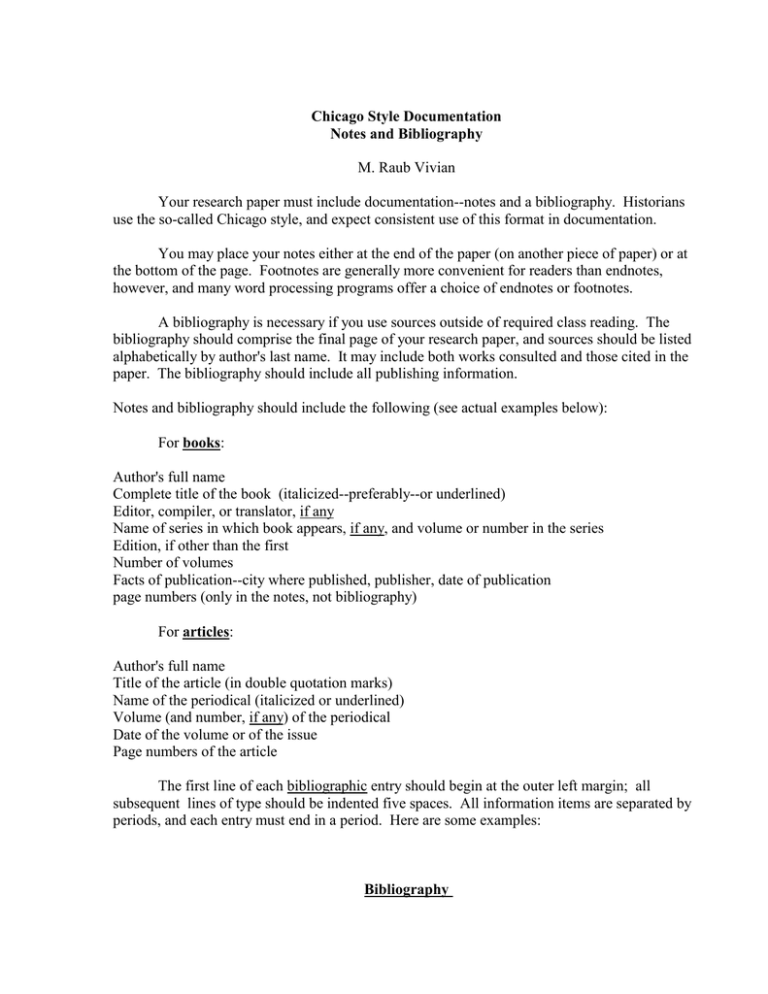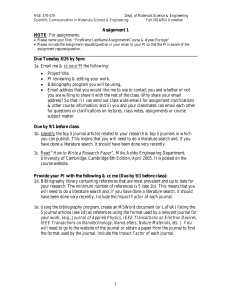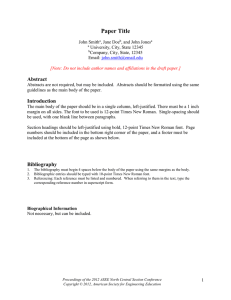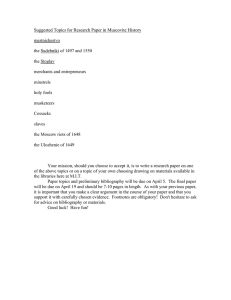Chicago Style Guide
advertisement

Chicago Style Documentation Notes and Bibliography M. Raub Vivian Your research paper must include documentation--notes and a bibliography. Historians use the so-called Chicago style, and expect consistent use of this format in documentation. You may place your notes either at the end of the paper (on another piece of paper) or at the bottom of the page. Footnotes are generally more convenient for readers than endnotes, however, and many word processing programs offer a choice of endnotes or footnotes. A bibliography is necessary if you use sources outside of required class reading. The bibliography should comprise the final page of your research paper, and sources should be listed alphabetically by author's last name. It may include both works consulted and those cited in the paper. The bibliography should include all publishing information. Notes and bibliography should include the following (see actual examples below): For books: Author's full name Complete title of the book (italicized--preferably--or underlined) Editor, compiler, or translator, if any Name of series in which book appears, if any, and volume or number in the series Edition, if other than the first Number of volumes Facts of publication--city where published, publisher, date of publication page numbers (only in the notes, not bibliography) For articles: Author's full name Title of the article (in double quotation marks) Name of the periodical (italicized or underlined) Volume (and number, if any) of the periodical Date of the volume or of the issue Page numbers of the article The first line of each bibliographic entry should begin at the outer left margin; all subsequent lines of type should be indented five spaces. All information items are separated by periods, and each entry must end in a period. Here are some examples: Bibliography Cameron, Averil. The Mediterranean World in Late Antiquity: AD 395-600. London: Routledge, 1993. Lee, A.D. Information and Frontiers: Roman Foreign Relations in Late Antiquity. Cambridge: Cambridge University Press, 1993. _____. "The Role of Hostages in Roman Diplomacy with Sasanian Persia." Historia: Zeitschrift für alte Geschichte 40:3 (1991): 366-374. Millar, Fergus. The Roman Near East: 31 BC-AD 337. Cambridge, Mass.: Harvard University Press, 1993. Schrier, Omert J. "Syriac Evidence for the Roman-Persian War of 421-422." Greek, Roman and Byzantine Studies 33:1 (1992): 75-86. Whittaker, C.R. Frontiers of the Roman Empire: A Social and Economic Study. Baltimore: The Johns Hopkins University Press, 1994. To create a note, first indent five spaces, then type the footnote number followed by a period (or superscript it (i.e., raise it) if possible, without a period). The first time you cite a work, the note should include the author's full name, the complete main title of the work (no subtitles), and the relevant page number(s). Subsequent references may give the author's last name only, and the relevant page number(s) (a shortened form of the title is optional, but no information about the book's publication is included). Whenever possible place footnote numbers at the end of a sentence, or at least a phrase; they are otherwise distracting to the reader. Sometimes you can combine two or three notes into one, typically at the end of a paragraph; it is crucial, however, that your note is clear about which citation goes with which statement of the paragraph. In notes, use commas to separate information items. All notes end with a period. You can use p. (or pp.) to indicate pages, or you may simply cite the page number without a "p." in front of it. Just be consistent in your usage. Here are some examples of notes: Notes 1. A.D. Lee, Information and Frontiers (Cambridge: Cambridge University Press, 1993), 24. 2. Omert J. Schrier, "Syriac Evidence for the Roman-Persian War of 421-422," Greek, Roman and Byzantine Studies 33:1 (1992), 75-77. 3. Ibid., 81. (*see below for an explanation of ibid.) 4. For an examination of the types of leverage used by Roman emperors in negotiations with Persian kings, see A.D. Lee, "The Role of Hostages in Roman Diplomacy with Sasanian Persia," Historia: Zeitschrift für alte Geschichte 40:3 (1991): 366-374. 5. Lee, 27. *(Ibid. is short for the Latin ibidem ("the same") and is used to refer to a single work cited in the note immediately preceding. It takes the place of listing author, title etc. It is, however, never used with the author's name or a title, although different page numbers can be cited after ibid. Ibid. is never underlined or italicized.) Two authors' names are separated by an "and," and in the case of more than three authors, the name of the first author is used, followed by a comma and "et al." (Latin for et alii, "and others"). (Culled from A Manual of Style, 12th ed. (Chicago: University of Chicago Press, 1967), ch. 15).





